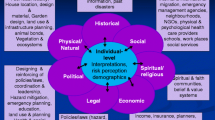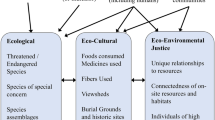Abstract
Natural hazards can be prominent and powerful mechanisms that impact the remediation and restoration of contaminated sites and the revitalization of communities associated with these sites. The potential for hazardous material releases following a natural disaster can exacerbate the impact of contaminated sites by causing the release of toxic or hazardous materials and inhibiting the restoration of the site as well as altering the long-term sustainable revitalization of adjacent communities. Disaster-related hazardous releases, particularly in population-dense areas, can create problems as difficult as the original site clean-up. Similarly, exposure of contaminated sites to natural hazards can enhance the probability of future issues associated with the site. This manuscript addresses the co-occurrence of 12 natural hazards (singly and in combination) and individual Superfund sites.








Similar content being viewed by others
References
Abbott PL (2004) Natural disasters, 4th edn. McGraw Hill, New York, NY
ARUP (2014) City resilience framework. The Rockefeller Foundation, ARUP Development International.
Associated Press (2007) Judge OKs deal over Katrina-related oil spill. 30 Jan 2007. http://www.msnbc.com/id/16892313/ns/us_news-life/t/judge-oks-deal-over-katrina-related-oil-spill/
Bardos P, Couon F, Erickson-Mulanax E, Hansen LJ, Maco B, Harclerode M, Hou D et al. (2018) Resilient remediation: addressing extreme weather and climate change. Creat Commun Value Remed 29(1):7–18
Bera G, Camargo K, Sericano JL, Liu Y, Sweet ST, Horney J, Jun M, Chiu W, Rusyn I, Wade T, Knap AH (2019) Baseline data for distribution of contaminants by natural disasters: results from a residential Houston neighborhood during Hurricane Harvey flooding. Heliyon 5:e2860
Binder S, Sanderson LM (1987) The role of the epidemiologist in natural disasters. Ann Emerg Med 16:1081–1084
Buck KD, Summers JK, Harwell LC, Smith LM, Hafner S (2019) Development of a multi-hazard landscape for exposure and risk interpretation: the PRISM approach. Curr Environ Eng 6(1):74–94
Burger J, Gochfeld M (2016) Initiating events, functional remediation, and assessment of risk to ecological resources. Ecol Indic 71:32–40
Carter JM, Kalman C (2019) Future floods & Superfund sites: toxic contamination risks in coastal communities. Presented American Geophysical Union, Fall Meeting 2019. https://ui.adsabs.harvard.edu/abs/2019AGUFMIN44B..07C/abstract
Cruz AM, Steinberg LJ, Luna R (2001) Identifying hurricane-induced hazardous material release scenarios in a petroleum refinery. Nat Hazards Rev 2:203–210
Dellapenna TM, Hoelscher C, Hill L, Al Mukaimi ME, Knap A (2020) How tropical cyclone flooding caused erosion and dispersal of mercury-contaminated sediment in an urban estuary: the impact of Hurricane Harvey on Buffalo Bayou and the San Jacinto Estuary, Galveston Bay, USA. Sci Total Environ 748:141226
EEA (European Environment Agency) (2019) Progress in management of contaminated sites. https://www.eea.europa.eu/data-and-maps/indicators/progress-in-management-of-contaminated-sites-3/assessment
Evangeliou N, Balkanski Y, Cozic A, Hao WM, Møller AP (2014) Wildfires in Chernobyl-contaminated forests and risks to the population and the environment: a new nuclear disaster about to happen? Environ Int 73:346–358
GAO (US Government Accounting Office) (2019) SUPERFUND—EPA should take additional actions to manage risks from climate change. GAO-20-73. https://www.gao.gov/assets/710/702158.pdf
Homer C, Dewitz J, Yang L, Jin S, Danielson P, Xian G et al. (2015) Completion of the 2011 national land cover database for the conterminous United States-representing a decade of land cover change information. Photogramm Eng Remote Sens 81(5):345–354
Hooda PS, Alloway BJ (1993) Effects of time and temperature on the bioavailability of Cd and Pb from sludge amended soils. J Soil Sci 44(1):97–110
Kato H, Onda Y, Teramage M (2012) Depth distribution of 137Cs, 134Cs, and 131I in soil profile after Fukushima Dai-Ichi nuclear power plant accident. J Environ Radioact 111:59–64
Krausmann E, Cruz AM, Affeltranger B (2010) The impact of the 12 May 2008 Wenchuan earthquake on industrial facilities. J Loss Prev Process Ind 23:242–248
Labunska I, Harrad S, Santillo D, Johnston P, Brigden K (2013) Levels and distribution of polybrominated diphenyl ethers in soil, sediment and dust samples collected from various electronic waste recycling sites within Guiyu town, southern China. Environ Sci: Process Impacts 15:503–511
Legal Information Institute (2020) 42 US code chapter 103—comprehensive environmental response, compensation, and liability. https://www.law.cornell.edu/uscode/text/42/chapter-103
Lin C, Wu Y, Lu W, Chen A, Liu Y (2007) Water chemistry and ecotoxicity of an acid mine drainage-affected stream in subtropical China during a major flood event. J Hazard Mater 142:199–207
Lindell M, Perry J (1996a) Addressing gaps in environmental emergency planning: hazardous materials releases during earthquakes. J Environ Plan Manag 39:529–543
Lindell M, Perry R (1996b) Identifying and managing conjoint threats: earthquake-induced hazardous materials releases in the US. J Hazard Mater Releases 50:31–46
Lindell M, Perry R (1998) Earthquake impacts and hazard adjustments of acutely hazardous materials facilities following the Northridge earthquake. Earthq Spectra 14:285–299
Melillo JM, Richmond T, Yohe GW (2014) Climate change impacts in the 11 United States: the third national climate assessment. US Global Change Research Program, 12. http://nca2014.globalchange.gov/report
Mooney C (2008) Is climate change causing an upsurge in US tornadoes? New Scientist 2667. 30 Jul 2008. https://www.newscientist.com/article/mg19926671-800-is-climate-change-causing-an-upsurge-in-us-tornadoes/
Nadal M, Marques M, Mari M, Domingo J (2015) Climate change and environmental concentrations of POPs: a review. Environ Res 143A:177–185
Olsen L (2017) EPA says Harvey flooded or may have damaged 13 Superfund sites. Houston Chronicle. 2 Sep 2017. https://www.chron.com/news/houston-weather/hurricaneharvey/article/EPA-says-only-13-Superfund-sites-flooded-and-or-12169602.php
Panagos P, Van Liedekerke M, Yigini Y, Montanarella L (2013) Contaminated sites in Europe: review of the current situation based on data collected through a European network. J Environ Public Health 2013:158764. https://doi.org/10.1155/2013/158764
Patra R. W, Chapman J. C, Lim R. P, Gehrke P. C, Sunderam R. M (2015) Interactions between water temperature and contaminant toxicity to freshwater fish. Environ Toxicol Chem 34(8):1809–1817
Pease P, Lecce S, Gares P, Rigsby C (2007) Heavy metal concentrations in sediment deposits on the Tar River floodplain following Hurricane Floyd. Environ Ecol 51(7):1103–1111
Pielke Jr RA, Gratz J, Landsea CW, Collins D, Saunders MA, Musulin R (2008) Normalized hurricane damage in the United States: 1900–2005. Nat Hazards Rev 9:29–42
Pugh C, Whung PY, Barber J, Essoka J, Priester N (2019) EPA research highlights—research to advance community resilience. em—the magazine for environmental managers. https://www.epa.gov/sites/production/files/2019-09/documents/research_to_advance_community_resilience.pdf
Rothwell JJ, Evans MG, Liddaman LC, Allott TEH (2007) The role of wildfire and gully erosion in particulate Pb export from contaminated peatland catchments in the southern Pennines. Uk Geomorphol 88:276–284
Science Daily (2008) Tornados, flooding may warn of climate change. Science Daily, 4 Jun. http://www.sciencedaily.com/releases/2008/06/08062231312.htm.
Sengul H, Santella N, Steinberg LJ, Cruz AM (2012) Analysis of hazardous material releases due to natural hazards in the United States. Disasters 36(4):723–743
Showalter PS, Myers MF (1992) Natural disasters as the cause of technological emergencies: a review of the decade 1980–1989. Working Paper 78. Natural Hazards Research Center, Boulder CO.
Showalter PS, Myers MF (1994) Natural disasters in the United States as release agents of oil, chemicals, or radiological materials between 1980-1989. Anal recommend Risk Anal 14:169–182
Smith K (2001) Environmental hazards: assessing risk and reducing disasters. Routledge Press, New York, NY
Summers JK, Smith LM, Harwell LC, Buck KD (2017a) Conceptualizing holistic community resilience to climate events: Foundation for a climate resilience screening index. GeoHealth 1:151–164
Summers JK, Harwell LC, Buck KD, Smith LM, Vivian DN, Bousquin JJ, Harvey JE, Hafner SF, McLaughlin MD (2017b). Resilience screening index (CRSI): an assessment of resilience to acute meteorological events and selected natural hazards. EPA600/R-17/238
Summers JK, Harwell LC, Smith LM, Buck KD (2018) Measuring community resilience to natural hazards—the natural hazard resilience screening index (NaHRSI): development and application to the US. GeoHealth 2:372–394. https://doi.org/10.1029/2018GH000160
Summers JK, Harwell LC, Buck KD, Smith LM, Vivian DN, Bousquin JJ, Harvey JE, Hafner SF, McLaughlin MD, McMillion CA (2020). Development of a cumulative resilience screening index (CRSI) for natural hazards: an assessment of resilience to acute meteorological events and selected natural hazards. EPA600/R-20/xxx.
Turetsky MR, Harden JW, Friedli HR, Flannigan M, Payne N, Crock J, Radke L (2006) Wildfires threaten mercury stocks in northern soils. Geophys Res Lett 33:L16403
US Climate Change Science Program (CCSP) (2008) Weather and climate extremes in a changing climate, regions of focus: North America, Hawaii, Caribbean, and US Pacific Islands, Synthesis and Assessment Product 3.3. June. http://www.climatescience.gov/Library/sap/sap3-3/final-report/default.htm
US Environmental Protection Agency (US EPA), Region 4 (2015) Five-year review report second five-year review report for macalloy corporation SCD003360476 Charleston, Charleston County, South Carolina August 2015. https://semspub.epa.gov/work/04/11014572.pdf
US Environmental Protection Agency (US EPA) (2020). Superfund national priorities list (NPL) sites with status information. https://epa.maps.arcgis.com/home/item.html?id=c2b7cdff579c41bbba4898400aa38815&view=list#overview
US Senate Committee on Environment and Public Works (2020) Oversight of the environmental protection agency. 20 May 2020. https://www.epw.senate.gov/public/index.cfm/2020/5/oversight-of-the-environmental-protection-agency
Van der Vink G, Allen R, Chapin J, Crooks M, Fraley W, Krantz J, Lavigne A, LeCuyer A, MacColl E, Morgan W, Ries B, Robinson E, Rodriquez K, Smith M, Sponberg K (1998) Why the United States is becoming more vulnerable to natural disasters. EOS Trans 79:533–537
Wang Y, Sun H, Zhu H, Yao Y, Chen H, Ren C, Wu F, Kannan K (2018) Occurrence and distribution of organophosphate flame retardants (OPFRs) in soil and outdoor settled dust from a multi-waste recycling area in China. Sci Total Environ 625:1056–1064
Wright IA, Paciuszkiewicz K, Belmer N (2018) Increased water pollution after closure of Australia’s longest operating underground coal mine: a 13-month study of mine drainage, water chemistry and river ecology. Water Air Soil Pollut 229:1–20
Young S, Balluz L, Malilay J (2004) Natural and technologic hazardous material releases during and after natural disasters: a review. Sci Total Environ 322:3–20
Acknowledgements
All research activities for this effort were funded through general US Environmental Protection Agency funding in FY20 to the Office of Research and Development. The authors express their appreciation to Dr. Joel Hoffman for a review of an early draft of the manuscript.
Author information
Authors and Affiliations
Corresponding author
Ethics declarations
Conflict of interest
The authors declare no competing interests.
Additional information
Publisher’s note Springer Nature remains neutral with regard to jurisdictional claims in published maps and institutional affiliations.
Rights and permissions
About this article
Cite this article
Summers, K., Lamper, A. & Buck, K. National Hazards Vulnerability and the Remediation, Restoration and Revitalization of Contaminated Sites—1. Superfund. Environmental Management 67, 1029–1042 (2021). https://doi.org/10.1007/s00267-021-01459-w
Received:
Accepted:
Published:
Issue Date:
DOI: https://doi.org/10.1007/s00267-021-01459-w




